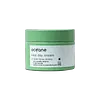What's inside
What's inside
 Key Ingredients
Key Ingredients

 Benefits
Benefits

 Concerns
Concerns

 Ingredients Side-by-side
Ingredients Side-by-side

Water
Skin ConditioningGlycerin
HumectantDimethicone
EmollientIsopropyl Isostearate
EmollientDipropylene Glycol
HumectantSqualane
EmollientPEG/PPG-18/18 Dimethicone
EmulsifyingSilica
AbrasiveTocopheryl Acetate
AntioxidantSodium Hyaluronate
HumectantOlea Europaea Fruit Extract
BleachingCentella Asiatica Extract
CleansingAloe Barbadensis Leaf Water
MaskingPalmitoyl Hexapeptide-12
Skin ConditioningTriticum Vulgare Bran Extract
Skin ConditioningCaffeine
Skin ConditioningMethyl Trimethicone
Skin ConditioningSorbitol
HumectantSodium Polyaspartate
HumectantPetrolatum
EmollientTrehalose
HumectantLactis Proteinum
Skin ConditioningLinoleic Acid
CleansingPyridoxine Dipalmitate
Skin ConditioningButylene Glycol
HumectantCholesterol
EmollientSucrose
HumectantPolysilicone-11
Glyceryl Polymethacrylate
PEG-150
HumectantPEG-8
HumectantHydroxyethyl Urea
HumectantHydroxyacetophenone
AntioxidantBHT
AntioxidantDisodium EDTA
Sodium Hexametaphosphate
MaskingSodium Benzoate
MaskingPotassium Sorbate
PreservativePhenoxyethanol
PreservativeWater, Glycerin, Dimethicone, Isopropyl Isostearate, Dipropylene Glycol, Squalane, PEG/PPG-18/18 Dimethicone, Silica, Tocopheryl Acetate, Sodium Hyaluronate, Olea Europaea Fruit Extract, Centella Asiatica Extract, Aloe Barbadensis Leaf Water, Palmitoyl Hexapeptide-12, Triticum Vulgare Bran Extract, Caffeine, Methyl Trimethicone, Sorbitol, Sodium Polyaspartate, Petrolatum, Trehalose, Lactis Proteinum, Linoleic Acid, Pyridoxine Dipalmitate, Butylene Glycol, Cholesterol, Sucrose, Polysilicone-11, Glyceryl Polymethacrylate, PEG-150, PEG-8, Hydroxyethyl Urea, Hydroxyacetophenone, BHT, Disodium EDTA, Sodium Hexametaphosphate, Sodium Benzoate, Potassium Sorbate, Phenoxyethanol
Glycerin
HumectantPhenyl Trimethicone
Skin ConditioningCaprylic/Capric Triglyceride
MaskingButylene Glycol
HumectantNeopentyl Glycol Diheptanoate
EmollientOlea Europaea Fruit Oil
MaskingNiacinamide
SmoothingBetaine
HumectantArachidyl Alcohol
EmollientDiisostearyl Malate
EmollientCentella Asiatica Extract
CleansingHydrogenated Phosphatidylcholine
EmulsifyingAsiaticoside
AntioxidantMadecassic Acid
Skin ConditioningAsiatic Acid
Skin ConditioningSucrose Stearate
EmollientMadecassoside
AntioxidantCholesterol
EmollientCeramide NP
Skin ConditioningDipropylene Glycol
HumectantGlycol Stearate Se
EmulsifyingCetearyl Alcohol
EmollientStearic Acid
CleansingHydrogenated Lecithin
EmulsifyingBehenyl Alcohol
EmollientArachidyl Glucoside
EmulsifyingDimethicone/Vinyl Dimethicone Crosspolymer
Skin ConditioningPolyacrylate-13
Polyisobutene
Polysorbate 20
EmulsifyingSorbitan Isostearate
EmulsifyingGlyceryl Stearate
EmollientPEG-100 Stearate
Panthenol
Skin ConditioningGlycosyl Trehalose
Emulsion StabilisingHydrogenated Starch Hydrolysate
HumectantXanthan Gum
EmulsifyingAllantoin
Skin ConditioningAdenosine
Skin ConditioningDisodium EDTA
1,2-Hexanediol
Skin ConditioningHydroxyacetophenone
AntioxidantParfum
MaskingAlpha-Isomethyl Ionone
PerfumingCitronellol
PerfumingHydroxycitronellal
PerfumingLinalool
PerfumingGlycerin, Phenyl Trimethicone, Caprylic/Capric Triglyceride, Butylene Glycol, Neopentyl Glycol Diheptanoate, Olea Europaea Fruit Oil, Niacinamide, Betaine, Arachidyl Alcohol, Diisostearyl Malate, Centella Asiatica Extract, Hydrogenated Phosphatidylcholine, Asiaticoside, Madecassic Acid, Asiatic Acid, Sucrose Stearate, Madecassoside, Cholesterol, Ceramide NP, Dipropylene Glycol, Glycol Stearate Se, Cetearyl Alcohol, Stearic Acid, Hydrogenated Lecithin, Behenyl Alcohol, Arachidyl Glucoside, Dimethicone/Vinyl Dimethicone Crosspolymer, Polyacrylate-13, Polyisobutene, Polysorbate 20, Sorbitan Isostearate, Glyceryl Stearate, PEG-100 Stearate, Panthenol, Glycosyl Trehalose, Hydrogenated Starch Hydrolysate, Xanthan Gum, Allantoin, Adenosine, Disodium EDTA, 1,2-Hexanediol, Hydroxyacetophenone, Parfum, Alpha-Isomethyl Ionone, Citronellol, Hydroxycitronellal, Linalool
 Reviews
Reviews

Ingredients Explained
These ingredients are found in both products.
Ingredients higher up in an ingredient list are typically present in a larger amount.
Butylene Glycol (or BG) is used within cosmetic products for a few different reasons:
Overall, Butylene Glycol is a safe and well-rounded ingredient that works well with other ingredients.
Though this ingredient works well with most skin types, some people with sensitive skin may experience a reaction such as allergic rashes, closed comedones, or itchiness.
Learn more about Butylene GlycolCentella Asiatica Extract (Centella) is derived from an herb native to Southeast Asia. It is famous for its anti-inflammatory and soothing properties.
Centella is rich in antioxidants and amino acids, such as Madecassic Acid and Asiaticoside.
Studies show the compounds in centella help with:
The combination of all these properties makes centella effective at soothing, hydrating, and protecting the skin.
Other great components of centella include Vitamin A, vitamin C, several B vitamins, and Asiatic Acid.
Fun fact: Centella has been used as a medicine and in food for many centuries. As a medicine, it is used to treat burns, scratches, and wounds.
Learn more about Centella Asiatica ExtractCholesterol is a class of organic molecules called lipids. It helps hydrate your skin and is essential to having a healthy skin barrier.
Our skin naturally contains cholesterol in the outermost layer. Besides cholesterol, it also contains ceramides and fatty acids. Cholesterol makes up about 1/4 of your skin's outer layer and barrier. Your skin barrier is responsible for keeping allergens and microbes out. Having a healthy skin barrier is also responsible for keeping your skin firm and plump.
Our bodies use cholestrol to create vitamin D, steroid hormones, and more.
Learn more about CholesterolDipropylene Glycol is a synthetically created humectant, stabilizer, and solvent.
This ingredient helps:
Dipropylene glycol is technically an alcohol, but it belongs to the glycol family (often considered part of the ‘good’ alcohols). This means it is hydrating and gentle on skin unlike drying solvent alcohols like denatured alcohol.
As a masking agent, Dipropylene Glycol can be used to cover the smell of other ingredients. However, it does not have a scent.
Studies show Dipropylene Glycol is considered safe to use in skincare.
Learn more about Dipropylene GlycolDisodium EDTA plays a role in making products more stable by aiding other preservatives.
It is a chelating agent, meaning it neutralizes metal ions that may be found in a product.
Disodium EDTA is a salt of edetic acid and is found to be safe in cosmetic ingredients.
Learn more about Disodium EDTAGlycerin is already naturally found in your skin. It helps moisturize and protect your skin.
A study from 2016 found glycerin to be more effective as a humectant than AHAs and hyaluronic acid.
As a humectant, it helps the skin stay hydrated by pulling moisture to your skin. The low molecular weight of glycerin allows it to pull moisture into the deeper layers of your skin.
Hydrated skin improves your skin barrier; Your skin barrier helps protect against irritants and bacteria.
Glycerin has also been found to have antimicrobial and antiviral properties. Due to these properties, glycerin is often used in wound and burn treatments.
In cosmetics, glycerin is usually derived from plants such as soybean or palm. However, it can also be sourced from animals, such as tallow or animal fat.
This ingredient is organic, colorless, odorless, and non-toxic.
Glycerin is the name for this ingredient in American English. British English uses Glycerol/Glycerine.
Learn more about GlycerinHydroxyacetophenone is antioxidant with skin conditioning and soothing properties. It also boosts the efficiency of preservatives.
This ingredient is not irritating or sensitizing.